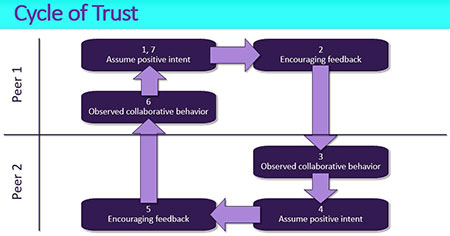What a different kind of dialogue two peers have if they approach each other with an assumption of positive intent – if they come to a conversation with the belief that the other person is a competent, responsible leader.
Assuming positive intent means acting under the assumption that the person with whom you are meeting is trustworthy and a team player – that they share your desire for the best possible outcome for the organization. You “act as if” they are going to behave in an effective and positive way.
In a conversation where you already assume the other person is trustworthy, your body language, how you act, and what you say totally changes. You look for messages that validate your assumptions and miss ones that don’t – a well-recognized strategy to reduce cognitive dissonance. Of course, this phenomenon works in both directions; whether you assume positive or negative attributions, your brain will labor to validate and reduce contradictions to your thinking.
We recommend that you look at the difference in yourself when you assume positive intent and trust rather than assume a predisposition of negativity and mistrust. We aren’t saying this is easy or that all people are trustworthy. Nevertheless, it is our experience that most mistrust in an organizational context results from miscommunication (assigning improper motives to another such as self-aggrandizement, for example) rather than misconduct, unethical acts, or egregious behavior.
Our belief is that, unless behavior is unethical or lacking integrity, even the “poorest” behavior can be discussed and a place of positive intention found. This will go a long way toward helping any team become a high performance team.
As to encouraging feedback, the best leaders ask for and listen to it – without prejudging it. (Thank you, Marshall Goldsmith, for the cycle of encouraging feedback. It was valuable when introduced and continues to be many years later.)
Consider the example of two peers, Sally and Joe. Sally had been frustrated with Joe. She made the effort to maintain an attitude of “positive intent” in her series of budget meetings with Joe. She made sure she understood how her own actions contributed to a frustrating situation and started to come to the meetings better prepared. She also encouraged feedback by listening to Joe’s comments before responding. Joe was pleased with Sally’s new collaborative approach, and their whole meeting process accelerated smoothly. By doing this, they saved company resources (time and money).
Unfortunately, leaders do not always listen, express appreciation, or follow up on feedback as Sally learned to do. The disruption this causes in relationships, teams, and organizations can be enormous, particularly if occurring in the higher ranks. The impact of senior leaders’ behaviors and of the examples they set is amplified, both because of leaders’ influence generally and because the tone of all behavior cascades down through the ranks.
That is why it is incumbent upon team leaders and senior executive officers to build trust on their teams and in their organization. They are responsible for creating constructive environments.
We acknowledge that this is simple in theory, yet hard to do. Barriers can be one’s history, triggers, or unwillingness to change. The payoffs, however, are worth the effort, among them:
- Reduced incidence of senseless decisions
- Better, more productive collaboration
- Creation of a foundation for candor, trust, and organizational agility.
Remember: Assume positive intent. Encourage feedback. Observe the improved collaboration. Watch the cycle feed on itself and grow.
Can you identify relationships you have or those on your team that need to follow the Cycle of Trust? What steps can you take to initiate it?










